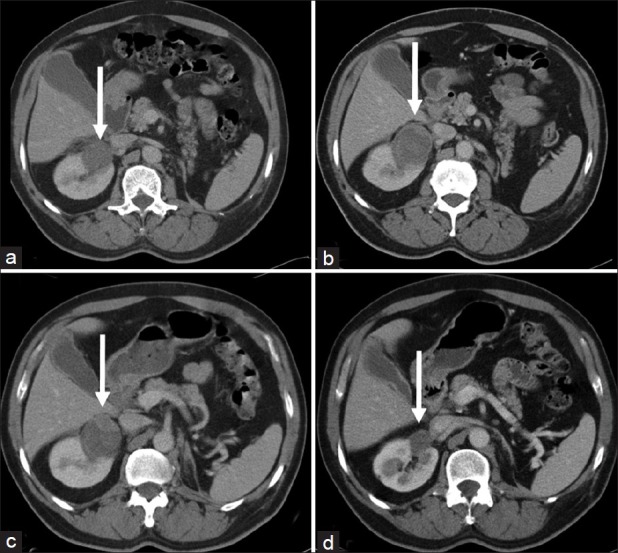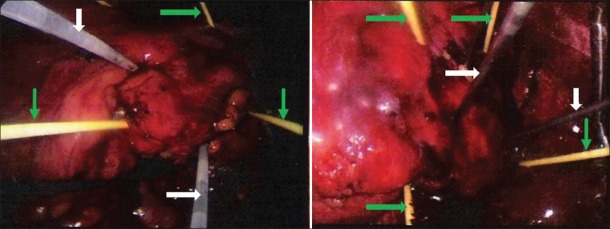Abstract
Recurrent tumors after renal ablative therapy present a challenge for clinicians. New ablative modalities, including microwave ablation (MWA), have very limited experience in methods of retreating ablation failures. Additionally, in MWA, no long-term outcomes have been reported. In patients having local tumor recurrence, options for surveillance or surgical salvage must be assessed. We present a case to help assess radio-frequency ablation (RFA) for salvage of failed MWA. We report a 63-year-old male with a 4.33-cm renal mass in a solitary kidney undergoing laparoscopic MWA with simultaneous peripheral fiber-optic thermometry (Lumasense, Santa Clara, CA, USA) as primary treatment. Follow-up contrast-enhanced computed tomography (CT) scan was performed at 1 and 4.3 months post-op with failure occurring at 4.3 months as evidenced by persistent enhancement. Subsequently, a laparoscopic RFA (LRFA) with simultaneous peripheral fiber-optic thermometry was performed as salvage therapy. Clinical and radiological follow-up with a contrast-enhanced CT scan at 1 and 11 months post-RFA showed no evidence of disease or enhancement. Creatinine values pre-MWA, post-MWA, and post-RFA were 1.01, 1.14, and 1.17 mg/ml, respectively. This represents a 15% decrease in estimated glomerular filtration rate (eGFR) (79 to 67 ml/min) post-MWA and no change in eGFR post-RFA. Local kidney tumor recurrence often requires additional therapy and a careful decisionmaking process. It is desirable not only to preserve kidney function in patients with a solitary kidney or chronic renal insufficiency, but also to achieve cancer control. We show the feasibility of RFA for salvage treatment of local recurrence of a T1b tumor in a solitary kidney post-MWA.
Keywords: Ablation, kidney, microwave, renal neoplasm
INTRODUCTION
New ablation technologies continue to emerge, with radio-frequency ablation (RFA) and cryoablation (CA) being the most studied. With thermal ablation residing as a viable option for the treatment of small renal masses,[1] new thermal therapies (microwave, laser interstitial therapy, irreversible electroporation, high-intensity focused ultrasound) are being evaluated, and possible salvage therapies in the case of recurrence are of importance. Microwave (MW) therapy is a new modality with limited experience in the kidney.[2–4] RFA has been used extensively in the salvage of small renal mass recurrences.[5] New technologies continue to emerge and it is important to have salvage methods in the event of failure with these new therapies. We present a case report of a patient with T1b disease, receiving microwave ablation (MWA) of the kidney with subsequent RFA with peripheral thermometry for treatment of local recurrence of the original tumor.
CASE REPORT
The patient presented in this case report was a 63-year-old male with a previous history of papillary renal cell carcinoma (RCC) of Fuhrman Grade of II for which he received a left radical nephectomy at age 51 in an outside facility. He presented with a 4.33-cm lower pole tumor of his solitary right kidney diagnosed via contrast-enhanced computed tomography (CT) scan [Figure 1a] and came to our facility for evaluation. In addition to previous RCC, this patient had an age-adjusted Charlson Comorbidity Index of 5 and a preoperative creatinine of 1.01 with an estimated glomerular filtration rate (eGFR) of 79 ml/min using the modification of diet in renal disease (MDRD) calculation. Treatment options including tumor extirpation and surveillance were offered as alternatives, and the risk and benefits of MWA were discussed with the patient.
Figure 1.

Contrast-enhanced CT scan depicting renal mass or ablation site (white arrow). (a) Pre-op 4.3-cm renal mass. (b) MWA post-op scan showing ablated tumor. (c) MWA post-op film showing recurrence at anterior portion of ablation zone. (d) RFA post-op scan shows no residual disease at 24 months
Laparoscopic microwave ablation
A transperitoneal approach was used. After exposure of the kidney and localization of the tumor, two 13-gauge, 3.7-cm MWA surgical antennae (Covidien, Valleylab, Boulder, CO, USA) were introduced through separate incisions. Fiber-optic thermal sensors were placed at the tumor periphery via visual and ultrasound (US) guidance utilizing a coaxial guide needle with radiopaque sheath (Huey, Cook Vascular, Inc., Vadergrift, PA, USA). Prior to ablation with the antenna(e) in place, a spring-loaded 16-gauge biopsy needle was utilized to take multiple biopsies under visual and US guidance. The microwave antenna was advanced into the tumor [Figure 2] and MWA commenced with simultaneous peripheral fiber-optic thermometry (Lumasense, Santa Clara, CA, USA) to determine treatment endpoints of >60°C. The microwave system used was the ValleyLab Evident® 915 MHz MW ablation system (Covidien Inc., Boulder, CO, USA) with two 13-gauge, 3.7-cm tip antenna(e) driven at 45 W. Ablation was performed for 23 min at 45 W over three separate deployments. This was based on when the tumor periphery temperatures reached the target temperature as in the techniques previously published.[6] Tumor biopsy showed papillary type RCC, Fuhrman grade II.
Figure 2.

Laparoscopic picture showing the ablation probes (white arrows) and peripheral fiber-optic temperature monitors (green arrows). The original MWA is shown on the left while the RFA is shown on the right
The patient had an uneventful postoperative course, and was followed with a contrast-enhanced CT scan at 1 month [Figure 1b] and at 4 months [Figure 1c]. The scan performed at 4 months post-op showed nodular thickening with enhancement at the ablation site read as recurrence [Figure 1d].
Salvage laparoscopic radio-frequency ablation
A transperitoneal approach was used. The procedure was performed using the same method as described above. Three 3.0-cm Cooltip® RFA probes (Covidien Inc.) were positioned in a triangular array with peripheral thermometry as described above [Figure 2]. Ablation was performed for a total of 31 min with all peripheral thermometry exceeding 60°C. Tumor biopsy at that time showed unspecified RCC. The patient had an uneventful postoperative course and was followed with a 1-month, 11-month, and 24-month clinical follow-up with 4-phase contrast-enhanced CT scan showing no enhancement of the tumor ablation site and no evidence of recurrent disease. Creatinine values pre-MWA, post-MWA, and post-RFA were 1.01, 1.14, 1.17 mg/ml, respectively. This represents a change in eGFR from 79 to 67 ml/min post-MWA (decreased 15%), and no change post-RFA.
DISCUSSION
Surgical treatment options for localized recurrent kidney tumors after failed ablation are active surveillance, repeat ablation, and salvage partial/radical nephrectomy. Surgical resection remains the standard of care for localized RCC because of 5-year cancer specific survival rate of more than 95%.[7] It is in the best interest of patients to conserve as many nephrons as achievable when choosing a treatment option to help avoid dialysis or renal transplantation, especially considering that small renal masses are usually low-grade, slow growing, with minimal metastatic potential.[8] The use of nephron sparing surgery (NSS) does not eliminate the risk for dialysis dependence or chronic renal insufficiency, but does reduce it when compared to nephrectomy and helps to preserve renal function.
Reablation of local tumor recurrences has been reported,[5] as 66-73% of patients who have local tumor recurrence post-CA or -RFA receive a repeat ablation[9] and 7.4% of all RFA lesions are reablated.[10] RFA is a viable option in the treatment of local tumor recurrence in the kidney.
Decision making can become difficult when assessing options for patients with a solitary kidney with previously treated tumors showing local recurrence. In a 63-year-old man, the risk of long-term dialysis or renal transplant likely outweighs the risk associated with failed salvage with thermal ablation. The case presented here shows that a patient previously treated with MWA or other new ablative technology, having local tumor recurrence in a solitary kidney, has the option of RFA with peripheral thermometry monitoring as salvage surgery. This case has a 24-month follow-up withno evidence of disease. Currently, no studies on salvage therapies for failed MWA are available. Feasibility of RFA salvage is shown here, but further studies are warranted in the future.
Complex patients often require detailed decision making between the physician and the patient. In patients with recurrent kidney tumors, all options should be weighed including active surveillance, repeat ablation, and salvage partial/radical nephrectomy. RFA with peripheral thermometry allows patients to conserve their solitary kidney while receiving treatment for their renal tumor recurrence. In the case of new thermal ablation technologies such as MWA, RFA is a viable salvage method for patients with local kidney tumor recurrence post ablation therapy.
Footnotes
Source of Support: Nil
Conflict of Interest: None.
REFERENCES
- 1.Campbell SC, Novick AC, Belldegrun A, Blute ML, Chow GK, Derweesh IH, et al. Guideline for management of the clinical T1 renal mass. J Urol. 2009;182:1271–9. doi: 10.1016/j.juro.2009.07.004. [DOI] [PubMed] [Google Scholar]
- 2.Castle SM, Salas N, Leveillee RJ. Initial experience using microwave ablation therapy for renal tumor treatment: 18-month follow-up. Urology. 2011;77:792–7. doi: 10.1016/j.urology.2010.12.028. [DOI] [PubMed] [Google Scholar]
- 3.Bai J, Hu Z, Guan W, Zhuang Q, Wang S, Liu J, et al. Initial experience with retroperitoneoscopic microwave ablation of clinical T(1a) renal tumors. J Endourol. 2010;24:2017–22. doi: 10.1089/end.2010.0204. [DOI] [PubMed] [Google Scholar]
- 4.Liang P, Wang Y, Zhang D, Yu X, Gao Y, Ni X. Ultrasound guided percutaneous microwave ablation for small renal cancer: Initial experience. J Urol. 2008;180:844–8. doi: 10.1016/j.juro.2008.05.012. [DOI] [PubMed] [Google Scholar]
- 5.Breda A, Anterasian C, Belldegrun A. Management and outcomes of tumor recurrence after focal ablation renal therapy. J Endourol. 2010;24:749–52. doi: 10.1089/end.2009.0658. [DOI] [PMC free article] [PubMed] [Google Scholar]
- 6.Wingo MS, Leveillee RJ. Central and deep renal tumors can be effectively ablated: Radiofrequency ablation outcomes with fiberoptic peripheral temperature monitoring. J Endourol. 2008;22:1261–7. doi: 10.1089/end.2008.0135. [DOI] [PubMed] [Google Scholar]
- 7.Hafez KS, Fergany AF, Novick AC. Nephron sparing surgery for localized renal cell carcinoma: Impact of tumor size on patient survival, tumor recurrence and TNM staging. J Urol. 1999;162:1930–3. doi: 10.1016/S0022-5347(05)68071-8. [DOI] [PubMed] [Google Scholar]
- 8.Sánchez-Martín FM, Millán-Rodríguez F, Urdaneta-Pignalosa G, Rubio-Briones J, Villavicencio-Mavrich H. Small renal masses: Incidental diagnosis, clinical symptoms, and prognostic factors. Adv Urol. 2008:310694. doi: 10.1155/2008/310694. [DOI] [PMC free article] [PubMed] [Google Scholar]
- 9.Matin SF, Ahrar K, Cadeddu JA, Gervais DA, McGovern FJ, Zagoria RJ, et al. Residual and recurrent disease following renal energy ablative therapy: A multi-institutional study. J Urol. 2006;176:1973–7. doi: 10.1016/j.juro.2006.07.016. [DOI] [PubMed] [Google Scholar]
- 10.Long L, Park S. Differences in patterns of care: Reablation and nephrectomy rates after needle ablative therapy for renal masses stratified by medical specialty. J Endourol. 2009;23:421–6. doi: 10.1089/end.2008.0234. [DOI] [PubMed] [Google Scholar]


